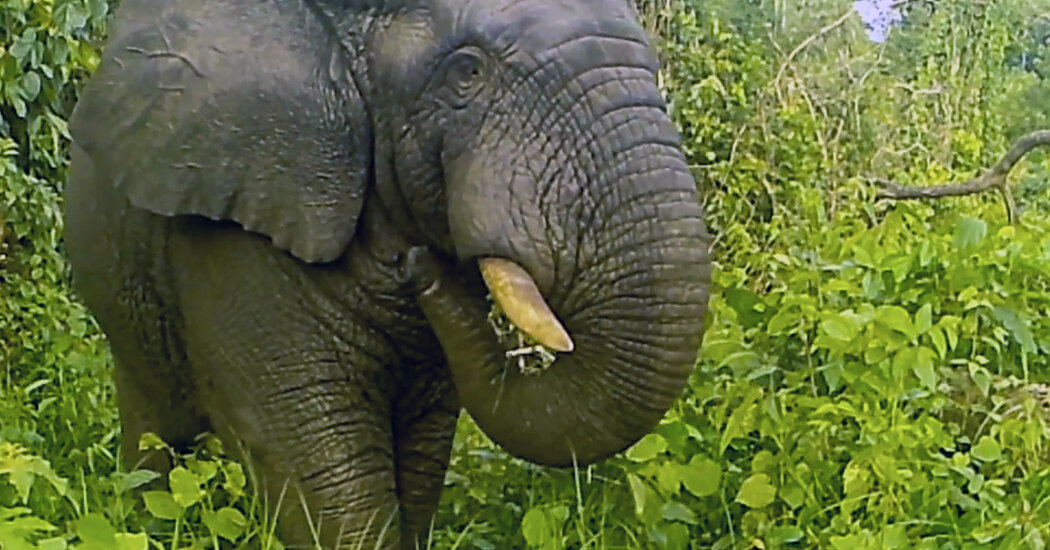

It’s a familiar, dreaded scenario in many parts of Africa and Asia: An elephant shows up, wanders into farmers’ fields, and tramples and eats crops. Sometimes farmers fight back, and elephants are killed.
That series of events seemed likely to play out recently when a forest elephant bull emerged from the dense jungle surrounding Gbarnjala village in northwestern Liberia.
But this time, things went differently. The munching bull heard an angry buzzing sound. It froze mid-chew, then turned trunk and high-tailed it out of there.
The bull had heard the sound of a disturbed hive of bees — and like elephants all over the world, it had learned to avoid the insect sound at all costs. But in this case, no bees were actually present. He had triggered a BuzzBox, an audio technology that aims to keep elephants and people apart.
Video footage of the incident is the first proof of concept that the boxes are an effective deterrent for critically endangered forest elephants, said Tina Vogt, technical director of Elephant Research and Conservation, a German nonprofit group that is testing the devices in Liberia.
“We have reports from farmers saying, ‘Oh yeah, it’s really working,’ but now this video is really evidence of that,” Dr. Vogt said.
Conflict between humans and elephants is an urgent problem across Africa. As human populations grow, people are encroaching on formerly wild areas, including some game reserves and national parks. “Elephants are getting more and more compressed into smaller spaces,” said Lucy King, head of the human-elephant coexistence program at Save the Elephants, which is helping to deploy the BuzzBox.
Elephants can take an entire year’s harvest overnight and occasionally even kill people they encounter. This breeds fear, anger and intolerance for the animals, eroding community support for their conservation and sometimes leading to retaliation.
“Human-elephant conflict feeds into the issue of local people being recruited into poaching gangs,” said Francesca Mahoney, founder and director of Wild Survivors, a nonprofit based in England that developed the BuzzBox.
Bees are an increasingly popular means of trying to quell that conflict.
San rock art from KwaZulu-Natal, South Africa, suggests ancient human awareness of elephants’ fear of bees, Dr. King said. That knowledge was first translated into Western scientific observation in 2002, when Maasai honey hunters in Kenya mentioned to researchers that elephants never damaged trees that contain beehives.
Dr. King has been studying elephants’ fear of bees since 2006 and applied what she learned to create specialized wire fences upon which beehives hang like pendulums. When elephants disturb the fence, the hives swing and the bees swarm. A study Dr. King led in 2017 revealed that beehive fences had an 80 percent success rate in keeping elephants off farms. “Finding a natural threat to scare elephants in the most holistic way possible, without terrifying them or making them go into pain, is really useful for management,” she said.
In some cases, though, hives full of aggressive African honey bees are not ideal. “You really don’t want to put live bees in places like school grounds or around water tanks in the middle of a community,” Dr. King said.
The BuzzBox provides the sound of bees without the accompanying stingers. First developed in 2017 by Wild Survivors’ chairperson, Martyn Griffiths, the latest model costs just $100 and is simple enough for local school children to build. The solar-powered boxes detect moving objects, which trigger audio to play for 30 seconds at a time. The devices can be programmed with up to six tracks of various sounds in addition to bees that elephants do not enjoy, including barking dogs, chain saws, human voices, gunshots or screaming goats. The newest version also contains two high-frequency strobe lights, Ms. Mahoney said, “so it’s a bit of a disco for night-raiding elephants.”
Dr. King stressed that bees and BuzzBoxes would not solve the problem of shrinking wild space in Africa, and rather were just two implements in “a whole human-elephant coexistence toolbox.”
But she hopes the Liberia example will inspire other groups working with forest elephants. “These BuzzBoxes are not only keeping elephants out, but getting communities to ask questions like, ‘Why should we care?’” Dr. King said. “The education opportunity is immense.”
24World Media does not take any responsibility of the information you see on this page. The content this page contains is from independent third-party content provider. If you have any concerns regarding the content, please free to write us here: contact@24worldmedia.com

Common Mistakes When Using Athletic Field Tarps

High-Performance Diesel Truck Upgrades You Should Consider

Warehouse Optimization Tips To Improve Performance

Fire Hazards in Daily Life: The Most Common Ignition Sources

Yellowstone’s Wolves: A Debate Over Their Role in the Park’s Ecosystem

Earth Day 2024: A Look at 3 Places Adapting Quickly to Fight Climate Change

Millions of Girls in Africa Will Miss HPV Shots After Merck Production Problem

This Lava Tube in Saudi Arabia Has Been a Human Refuge for 7,000 Years

Four Wild Ways to Save the Koala (That Just Might Work)

National Academy Asks Court to Strip Sackler Name From Endowment

Ways Industrial Copper Helps Energy Production

The Ins and Out of Industrial Conveyor Belts